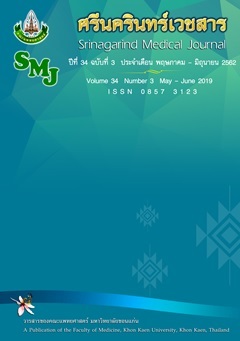The Prevalence of Corona Mortis in North-Eastern Thai Fresh Cadavers and the Safety Zone for Herniorrhaphy
Keywords:
corona mortis; herniorrhaphy; fresh cadavers; pubic tubercleAbstract
Background and Objective: Corona mortis is a collateral circulation between the external and internal iliac system. This anatomical variant plays an important role in clinical and surgical procedure since it may cause life threatening during hernia repairs or other surgical procedures of the pubis and acetabulum. Several studies reported the incidence of corona mortis and its distance to symphysis pubis, however, little information regarding the distance from this anatomical variant to pubic tubercle, important landmark for a herniorrhaphy incision area. This study aimed to investigate the incidence of corona mortis and its distance to pubic tubercle in North-eastern Thais fresh cadavers.
Methods: Twenty North-eastern Thais fresh cadavers, 40 hemipelvises were dissected to explore arterial and venous corona mortis or both. The distance between corona mortis and pubic tubercle was measured.
Results: Arterial-venous or both corona mortis were present 60%. The incidence of corona mortis in male (75% of 28 hemipelvises) was greater than those in female (25 % of 12 hemipelvises). The prevalence side of corona mortis was equally found. Subsequently, the distance from corona mortis to the pubic tubercle was ranged from 2.21-4.50 cm.
Conclusion: In conclusion, the high prevalence of corona mortis in fresh Thai cadavers was demonstrated. We could suggest that the safety zone for an incision area in open herniorrhaphy could be less than 2.21 cm from pubic tubercle.
References
2. Kockerling F, Simons MP. Current concepts of inguinal hernia repair. Visc Med 2018; 34: 145-50.
3. Rosenberg J, Bisgaard T, Kehlet H, Wara P, Asmussen T, Juul P, et al. Danish Hernia Database recommendations for the management of inguinal and femoral hernia in adults. Dan Med Bull 2011; 58: C4243.
4. Berger D. Evidence-Based Hernia Treatment in Adults. Dtsch Arztebl Int 2016; 113: 150-7; quiz 158.
5. Amid PK. Groin hernia repair: open techniques. World J Surg 2005; 29: 1046-51.
6. Rausa E, Asti E, Kelly ME, Aiolfi A, Lovece A, Bonitta G, et al. Open Inguinal Hernia Repair: A Network Meta-analysis Comparing Self-Gripping Mesh, Suture Fixation, and Glue Fixation. World J Surg 2019; 43: 447-56.
7. Sun P, Cheng X, Deng S, Hu Q, Sun Y, Zheng Q. Mesh fixation with glue versus suture for chronic pain and recurrence in Lichtenstein inguinal hernioplasty. Cochrane Database Syst Rev 2017; 2: CD010814.
8. Yasuda T, Matsuda A, Miyashita M, Matsumoto S, Sakurazawa N, Kawano Y, et al. Life-threatening hemorrhage from the corona mortis after laparoscopic inguinal hernia repair: Report of a case. Asian J Endosc Surg 2018; 11: 169-72.
9. Darmanis S, Lewis A, Mansoor A, Bircher M. Corona mortis: an anatomical study with clinical implications in approaches to the pelvis and acetabulum. Clin Anat 2007; 20: 433-9.
10. Karakurt L, Karaca I, Yilmaz E, Burma O, Serin E. Corona mortis: incidence and location. Arch Orthop Trauma Surg 2002; 122: 163-4.
11. Al Talalwah W. A new concept and classification of corona mortis and its clinical significance. Chin J Traumatol 2016; 19: 251-4.
12. Darmanis S, Kahler A, Spangberg L, Kamali-Moghaddam M, Landegren U, Schallmeiner E. Self-assembly of proximity probes for flexible and modular proximity ligation assays. Biotechniques 2007; 43: 443-4, 446, 448 passim.
13. Rutledge RH. Cooper's ligament repair for adult groin hernias. Surgery 1980; 87: 601-10.
14. Conaghan P, Hassanally D, Griffin M, Ingham Clark C. Where exactly is the deep inguinal ring in patients with inguinal hernias? Surg Radiol Anat 2004; 26: 198-201.
15. Ates M, Kinaci E, Kose E, Soyer V, Sarici B, Cuglan S, et al. Corona mortis: in vivo anatomical knowledge and the risk of injury in totally extraperitoneal inguinal hernia repair. Hernia 2016; 20: 659-65.
16. Gilroy AM, Hermey DC, DiBenedetto LM, Marks Jr SC, Page DW, Lei Q. Variability of the obturator vessels. Clinical Anatomy: The Official Journal of the American Association of Clinical Anatomists and the British Association of Clinical Anatomists 1997; 10: 328-32.
17. Stavropoulou Deli A, Anagnostopoulou S. Corona mortis: anatomical data and clinical considerations. Australian and New Zealand Journal of Obstetrics and Gynaecology 2013; 53: 283-6.
18. Teague DC, Graney DO, Routt Jr MC. Retropubic vascular hazards of the ilioinguinal exposure: a cadaveric and clinical study. Journal of orthopaedic trauma 1996; 10: 156-9.
19. Tornetta III P, Hochwald N, Levine R. Corona Mortis: Incidence and Location. Clinical Orthopaedics and Related Research (1976-2007) 1996; 329: 97-101.
20. Sanna B, Henry BM, Vikse J, Skinningsrud B, Pekala JR, Walocha JA, et al. The prevalence and morphology of the corona mortis (Crown of death): A meta-analysis with implications in abdominal wall and pelvic surgery. Injury 2018; 49: 302-8.
21. Pellegrino A, Damiani GR, Marco S, Ciro S, Cofelice V, Rosati F. Corona mortis exposition during laparoscopic procedure for gynecological malignancies. Updates in surgery 2014; 66: 65-8.
22. Berberoglu M, Uz A, Ozmen MM, Bozkurt MC, Erkuran C, Taner S, et al. Corona mortis: an anatomic study in seven cadavers and an endoscopic study in 28 patients. Surg Endosc 2001; 15: 72-5.
23. Darmanis S, Lewis A, Mansoor A, Bircher M. Corona mortis: an anatomical study with clinical implications in approaches to the pelvis and acetabulum. Clinical Anatomy: The Official Journal of the American Association of Clinical Anatomists and the British Association of Clinical Anatomists 2007; 20: 433-9.
24. Karakurt L, Karaca I, Yilmaz E, Burma O, Serin E. Corona mortis: incidence and location. Archives of orthopaedic and trauma surgery 2002; 122: 163-4.
25. Okcu G, Erkan S, Yercan H, Ozic U. The incidence and location of corona mortis A study on 75 cadavers. Acta Orthopaedica Scandinavica 2004; 75: 53-5.
26. Sarikcioglu L, Sindel M, Akyildiz F, Gur S. Anastomotic vessels in the retropubic region: corona mortis. Folia morphologica 2003; 62: 179-82.




